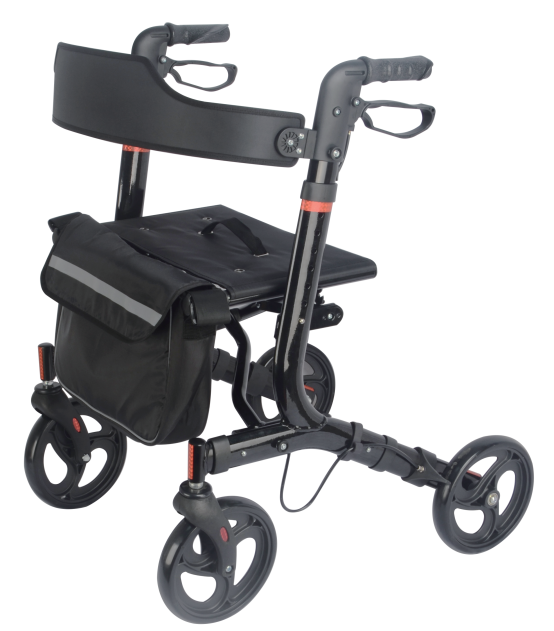As people age, the challenges of maintaining mobility and independence increase. One of the most common tools that can significantly improve the mobility of elderly individuals is a rollator. A rollator is a walker equipped with wheels, handlebars, and often a seat. Unlike traditional walkers, which require users to lift the walker with each step, rollators are designed to be pushed along the ground, making them easier to use and more comfortable for many older adults. This article will explore why elderly individuals need to use rollators, including their physical benefits, emotional advantages, and the increased safety they provide.
1. Improved Mobility and Independence
For many elderly individuals, physical limitations such as arthritis, muscle weakness, or balance issues can make walking long distances difficult or even dangerous. Rollators provide support and stability, allowing users to walk more comfortably and for longer periods. The wheels make movement much easier, reducing the effort required to lift and propel the walker as is necessary with a traditional walker. This ease of use helps the elderly regain some of their independence and confidence in performing daily activities like walking, shopping, or simply moving around the house.
Using a rollator means that older adults can maintain a certain level of autonomy, which is essential for mental and emotional well-being. Being able to perform daily activities with less assistance from others encourages independence and helps individuals retain a sense of self-sufficiency. This independence is important for quality of life and can help reduce the need for full-time caregiving.

2. Enhanced Safety
Falls are a significant concern for the elderly. According to the Centers for Disease Control and Prevention (CDC), one in four adults aged 65 and older falls each year, and falls are the leading cause of injury-related death in this age group. Rollators help reduce the risk of falls in several ways. First, they provide a stable support system for the user, with the handlebars offering a solid grip to help maintain balance. The presence of wheels allows for smoother movement, which decreases the likelihood of tripping or stumbling over obstacles like uneven sidewalks or carpeted floors.
Furthermore, many rollators come with built-in brakes, allowing users to stop and stabilize themselves when needed. These brakes can be particularly helpful when sitting on the rollator or when navigating inclines or uneven ground. In addition, many models feature a seat, offering users a place to rest if they feel tired, which can help prevent fatigue-related falls. Overall, the added stability and safety features make rollators an essential tool for elderly people who are at a higher risk of falling.
3. Physical Exercise and Social Interaction
A rollator encourages movement, which is vital for maintaining physical health. Regular walking can improve circulation, strengthen muscles, and improve flexibility. Using a rollator allows elderly individuals to engage in low-impact exercise that is less likely to cause strain or injury compared to activities like running or high-impact aerobics. Regular walking with the support of a rollator can also help maintain balance and coordination, reducing the risk of future falls.
In addition to the physical benefits, walking with a rollator can also encourage social interaction. Elderly individuals who might otherwise be reluctant to go outside due to mobility issues can feel more comfortable leaving the house when they have the support of a rollator. This can lead to increased socialization with family, friends, and community members, which is important for mental health. Social isolation is a common problem among older adults, and the ability to engage in outdoor activities can help combat feelings of loneliness and depression.
4. Psychological Benefits
The use of a rollator can also have a positive impact on the psychological well-being of elderly individuals. As they regain mobility and independence, they may experience an improved sense of self-esteem and dignity. Many elderly individuals feel a loss of control over their lives as they age, but with the help of a rollator, they can maintain a sense of autonomy, which can lead to an improved outlook on life.
Moreover, the ability to move more freely can reduce feelings of helplessness or frustration that often accompany mobility challenges. The physical support provided by a rollator can translate into emotional reassurance, allowing elderly individuals to feel more confident when navigating their environment.
Conclusion
Rollators are invaluable tools for elderly individuals who face mobility challenges. They offer a wide range of benefits, including improved mobility, enhanced safety, better posture, and reduced joint strain. Rollators encourage physical activity, provide social opportunities, and offer a sense of independence and confidence. For many elderly people, the use of a rollator can significantly improve their quality of life, allowing them to engage more fully in daily activities and enjoy their lives with greater comfort and security. As the global population continues to age, the importance of tools like rollators will only continue to grow in helping the elderly maintain their mobility, independence, and overall well-being.
Post time: Dec-05-2024






